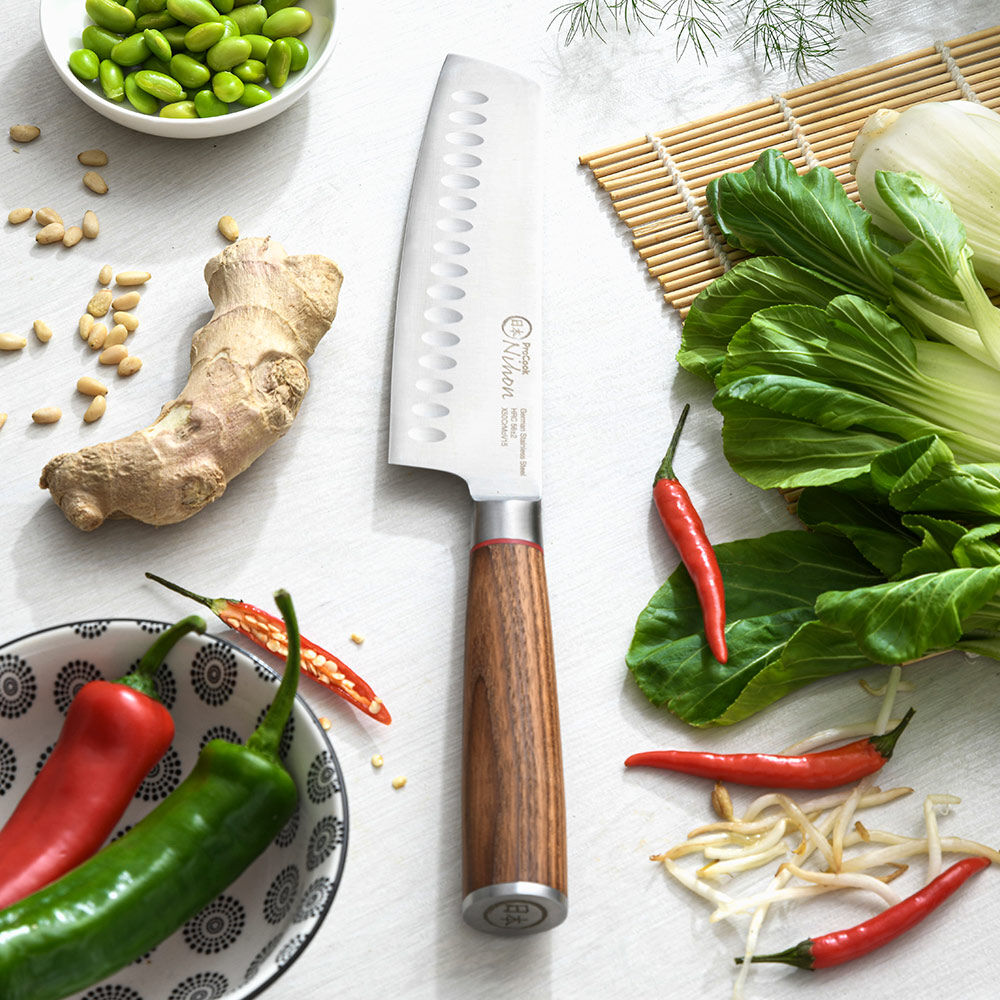ProCook Help Hub
The latest inspiration and advice from the experts at ProCook
Whether you're a keen cook or new to the kitchen, choosing the right kitchen knife can help you prepare food easier, faster and safer. However, with so many different types of kitchen knives available, how do you go about picking the right one for you and your cooking style and experience?
It's important to have the right blades at your fingertips. By using sharp and well-balanced knives, cooking (especially meal preparation) will be made much easier. Our knife buying guide is here to offer advice on choosing the best kitchen knives for you.
There’s a lot to unpack and consider when buying kitchen knives, but comfort is key. Every knife should act like an extension to the user’s hand, which is why you should always try a knife before buying. Pop to your local ProCook store and speak to a member of staff. They will be more than happy to help, allowing you to hold and try out knives from the ProCook knife ranges, so you can find your perfect knife range.
Material
Knives are an investment, which is why finding a knife made from high quality materials is important. ProCook knives are made from the following materials: stainless steel or Damascus stainless steel with added carbon for improved durability, a strong, sharp cutting edge and high tarnish resistance.
Weight
There’s no ideal weight for a knife; it comes down to personal preference. You want to avoid using knives that are so heavy, they strain your wrists and make cutting uncomfortable. However, a little bit of weight can make meal preparation easier as it helps glide through your ingredients.
Balance
Weight is important, but so is balance. The weight of the handle and blade should be equally balanced in your hand, for maximum efficiency.
Comfort
While the weight and balance can impact the comfort of a kitchen knife, so does the handle’s shape, size and material. Each of our ProCook knife ranges feature unique handle types - from contoured to all-steel construction - so you can find the right knife style.
Things to Consider when Buying a Knife Set
Explore our ProCook Knife Ranges
Gourmet Classic
Based on traditional kitchen knife designs, our Gourmet Classic range features a timeless design with contoured, traditional triple rivet handles for maximum comfort and modern European blade shapes for a strong, sharp cutting edge.
Each Gourmet Classic knife includes:
- An X30 stainless steel blade crafted from durable, stainless steel composed of 0.3% carbon for impressive edge retention and 13% chrome for tarnish resistance
- Blades that are hand sharpened on a grinding wheel for a razor-sharp cutting edge
- Even weight distribution for greater comfort and control
- Traditional triple rivet handles and timeless good looks
- HRC (the official Rockwell hardness rating) of 52+2
Gourmet Kiru
Featuring an all-steel construction for a sleek, contemporary design, our Gourmet Kiru offers modern beauty and design with incredible durability and a sharp cutting edge for added precision.
Each Gourmet Kiru knife includes:
- Blades crafted from X30 stainless steel composed of 0.3% carbon and 13% chrome for durability, improved edge retention, and high corrosion resistance
- A hand sharpened blade for a razor-sharp cutting edge
- An Asian inspired blade shape
- Seamless all-steel construction for a sleek, contemporary design
- Ergonomic handles embellished with a modern, diamond design
- HRC (the official Rockwell hardness rating) of 52+2
Professional X50 Chef
Combining beauty and functionality, our Professional X50 Chef range includes classic French styling and a sharp cutting edge for superior slicing, dicing, and chopping.
Each Professional X50 Chef knife includes:
- Blades crafted from X50 German stainless steel containing 0.5% carbon and 15% chrome, so the blades stay sharper for longer and offer higher corrosion resistance
- A beautiful triple rivet handle and European blade shape, inspired by the classic French style
- Contoured handles and an anti-slip full length front bolster for added comfort, control, and precision
- HRC (the official Rockwell hardness rating) of 55+2 for easy sharpening and durability
Professional X50 Contour
Seriously sharp, our Professional X50 Contour range features German X50 stainless steel blades combined with carbon and chrome for a razor-sharp cutting edge, improved edge retention and high corrosion resistance. Beautifully weighted and ergonomic handles for precise cutting and a comfortable grip.
Each Professional X50 Contour knife includes:
- Durable and sharp blades crafted from X50 German stainless steel composed of 0.5% carbon and 15% chrome, so your blades stay sharper for longer and have a high corrosion resistance
- A contour handles and their distinctive design for an ergonomic hold and superior comfort
- A well-balanced rear bolster and tapered front bolster for excellent balance, control and precision
- A hand sharpened blade that has been stone ground by hand for a super sharp cutting edge
- HRC (the official Rockwell hardness rating) of 55+2, which ensures durability and easy sharpening
Nihon X50
Inspired by Japan, our Nihon X50 range offers Asian inspired blade shapes, carbonised ash wood handles, and an etching of the Japanese symbol for Japan. Each member of our Nihon X50 range offers elegance as well as a superior cutting edge for easy meal preparation.
Each Nihon X50 knife includes:
- A blade crafted from durable X50 German stainless steel combined of 0.5% carbon and 15% chrome for greater edge retention and high corrosion resistance
- Each carbonised ash wood handle is baked to removed moisture content, so you can enjoy an exceptionally durable, richly toned handle that adds beauty and charm
- An etched rear bolster that displays the Japanese symbol for Japan
- A blade that’s stone ground by hand by a grinding wheel for a superior cutting edge that glides through food easily
- HRC (the official Rockwell hardness rating) of 56+2 for incredible hardness, durability and easy sharpening
Elite AUS8
Crafted from premium Japanese stainless steel for extra wear-resistance, our Elite AUS8 range stands out due to its remarkable ice hardened sharp blade providing excellent cutting properties. Complete with modern, contoured handles, so you can meal prep safely and comfortably.
Each Elite AUS8 knife includes:
- Blades crafted from a premium Japanese stainless steel composed of 0.8% carbon for outstanding edge retention and 15% chrome for high corrosion resistance
- Ice hardened for durability and an extra sharp edge
- Triple rivet handles which are made from the highest quality wood resin composite for comfort and durability. Each handle is also ergonomically contoured for a supremely comfortable hold
- European blade shapes and a blade that is stone ground by hand on a grinding wheel for a super sharp cutting edge
- HRC (the official Rockwell hardness rating) of 58+2 for fantastic longevity and easier sharpening
Damascus 67
Our Damascus 67 range is inspired by the traditional techniques of Echizen, Japan and encompasses beautiful Japanese artistry. Including a VG10 high-carbon core encased in 66 layers of world renowned Japanese Damascus stainless steel for a lasting cutting edge, superior sharpness, and a strikingly beautiful blade pattern that is unique to every knife. Each knife features a stamped rear bolster and a decorative rivet with the Japanese symbol for "Strength."
Each Damascus 67 knife includes:
- An impressive VG10 high-carbon core with 1% carbon for a supreme, long-lasting edge, which is encased in 66 layers of highly valued Japanese Damascus stainless steel for superior hardness and a unique, mottled pattern
- G10 handles, a material made by layering fibreglass cloth soaked in epoxy resin, which is then compressed and baked for ultimate strength and beauty
- Japanese inspired blade shapes, perfectly shaped for every task, and a stamped rear bolster with a decorative rivet featuring a Japanese symbol translating to "Strength"
- Blades stone ground on a grinding wheel for unrivalled, razor-sharp cutting edge
- HRC (the official Rockwell hardness rating) of 60, which is the optimal hardness for VG10 steel
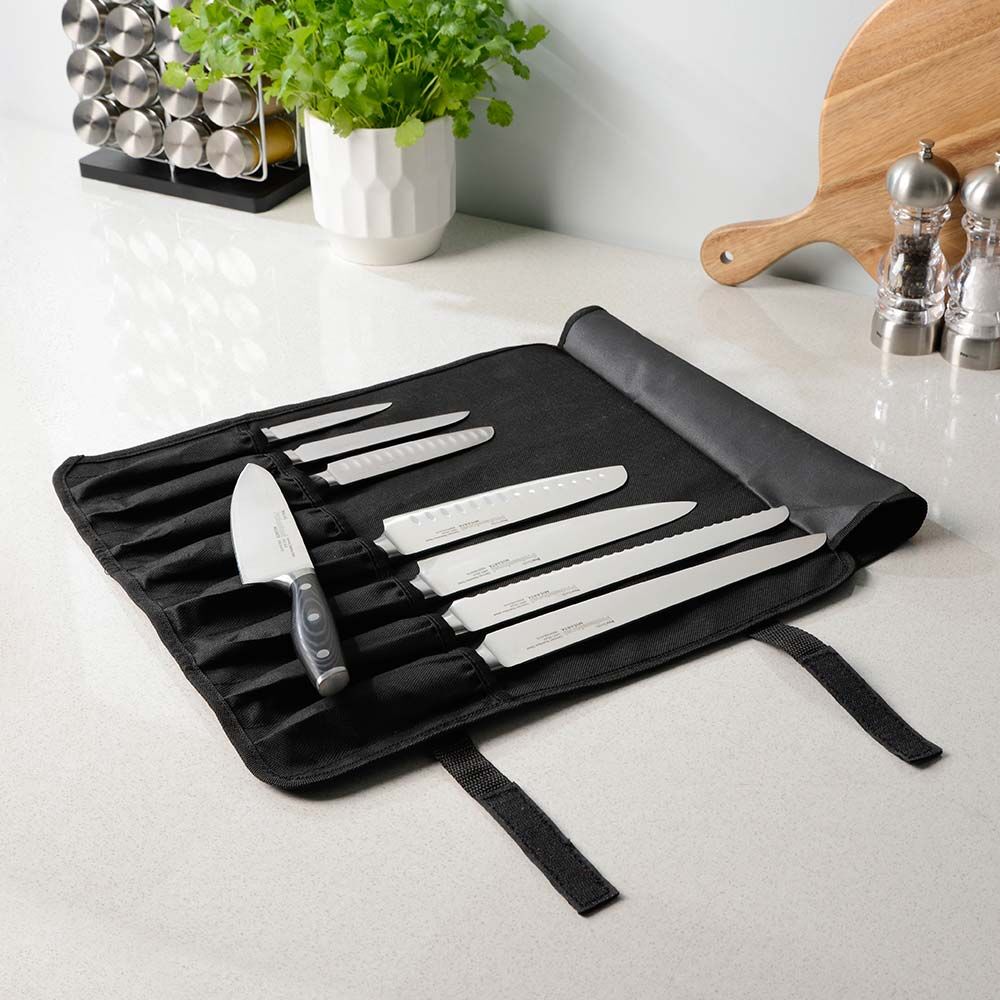
Professional X50 Micarta, Gourmet Kiru and Nihon X50
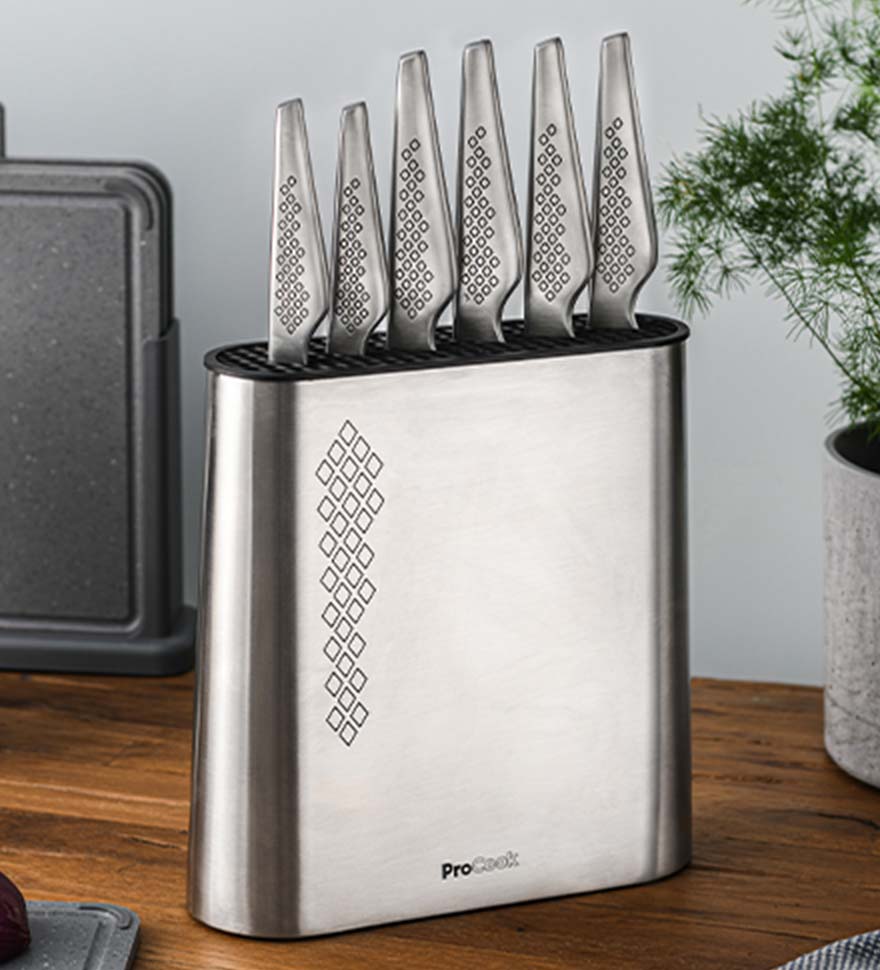
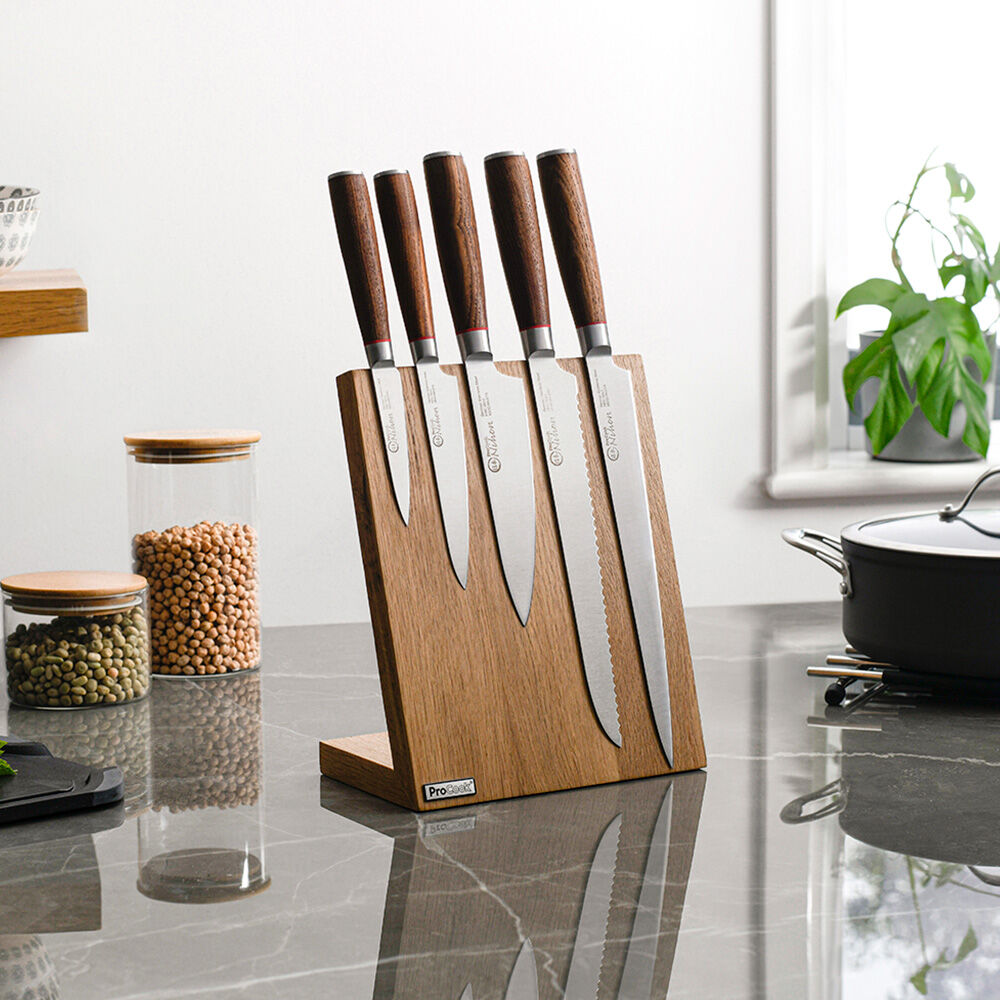
The Different Types of Knives Explained
There are numerous types of knives, so if you are unfamiliar with different knife types and what each one specialises in, the process of finding the right knives for you can be overwhelming. It’s important to learn the different types of knives and the jobs each one does so that you can improve your meal prep and safety in the kitchen. Using a knife incorrectly can be dangerous and a hazard.
We have a variety of knife ranges including our Japanese knife sets and Western style chef knives. Read on to find what purpose each type of knife is designed for, so you can find the right knife for your needs.
Chefs Knife
A chefs knife is the perfect multi-purpose knife and considered a kitchen essential. Ideal for chopping, cutting, slicing and dicing a variety of vegetables, fruits and meats.
Features a curved blade that allows you to 'rock' the knife back and forth when cutting. Because of its broad heel, a chef knife can withstand quite a lot of heavy-duty cutting and chopping, making it ideal for cutting hardier ingredients like potatoes or other root vegetables.
Santoku Knife
The core difference between a santoku and chefs knife is their origin and blade shape, although both are general purpose knives. Typically, a santoku has a wide blade with no tip and a dull spine that curves downwards to reach the straight-edge front blade. This means you do not need to ‘rock’ when cutting and can simply cut down in a straight motion.
What is a Santoku knife used for?
Much like a chef’s knife, you can use a Santoku knife to cut a variety of ingredients like vegetables, fruit and meat. However, a Santoku knife is also great for precise and clean slicing of raw fish. Allows food to easily fall away from the blade.
Nakiri Knife
Otherwise known as a Japanese vegetable knife, a Nakiri knife has a broad and rectangular shape and a very sharp blade. Its wide blade can also be used to crush garlic.
Utility Knife
The blade of a utility knife is longer than a paring knife, narrower than a chef's knife and works well for slicing mid-sized fruits and vegetables, pieces of meat, cheeses and cutting through sandwiches. A utility knife is a handy, general-purpose knife.
Paring Knife
Not to be confused with a utility knife, a paring knife is a short and slim knife that has an incredibly pointed tip and is usually very light. The knife’s lightness makes it incredibly easy to handle. Use to peel small fruits and vegetables.
Bread Knife
One of the most distinct knives, a bread knife has a very long blade that has sharp serrated edges. The serrated blade makes the knife ideal for cutting softer items as it stops it from squishing the food and ruining its shape.
What is a bread knife used for?
As the name suggests, a bread knife is perfect for slicing bread without putting too much pressure onto the loaf and crushing the shape. However, a bread knife can also be used to cut other soft foods like cakes.
Cleaver
Also referred to as a butcher knife, a cleaver is a large knife with a flat and rectangular-shaped blade that is usually weighty. A cleaver can come in a variety of sizes, depending on how you wish to use it. What’s more, a cleaver will typically feature a hole near the blade’s spine and in the top corner, so they can be hung rather than stored in a drawer.
What is a cleaver used for?
A cleaver is used to chop raw meat so that it can be divided into smaller portions before it is cooked. The blade is designed so that it can cut through bone, making it perfect for butchery processes.
Filleting and Boning Knives
A filleting knife is perfect for filleting fish whereas a boning knife is used to debone and cut up meat. Both knives are different in size, but have similarities such as a flexible blade and a tapered and pointed tip. The blades are thinner and flexible so that you can move around the meat easier.
What are filleting and boning knives used for?
Both these knives are used to debone meat and fish as well as cut them into your desired shapes.
Carving Knife
A carving knife has a long, slim blade that is tapered to a sharp point. This is typically considered one of the longest knives that can be found in the kitchen. The science behind this knife is that, due to its narrow and long blade, you can create cleaner and more uniform slices.
What is a carving knife used for?
Carving knives are great for cutting and slicing through meat – both raw and cooked. However, you can use a carving knife for various foods like vegetables and even cake.
Check out some of our best selling knives:
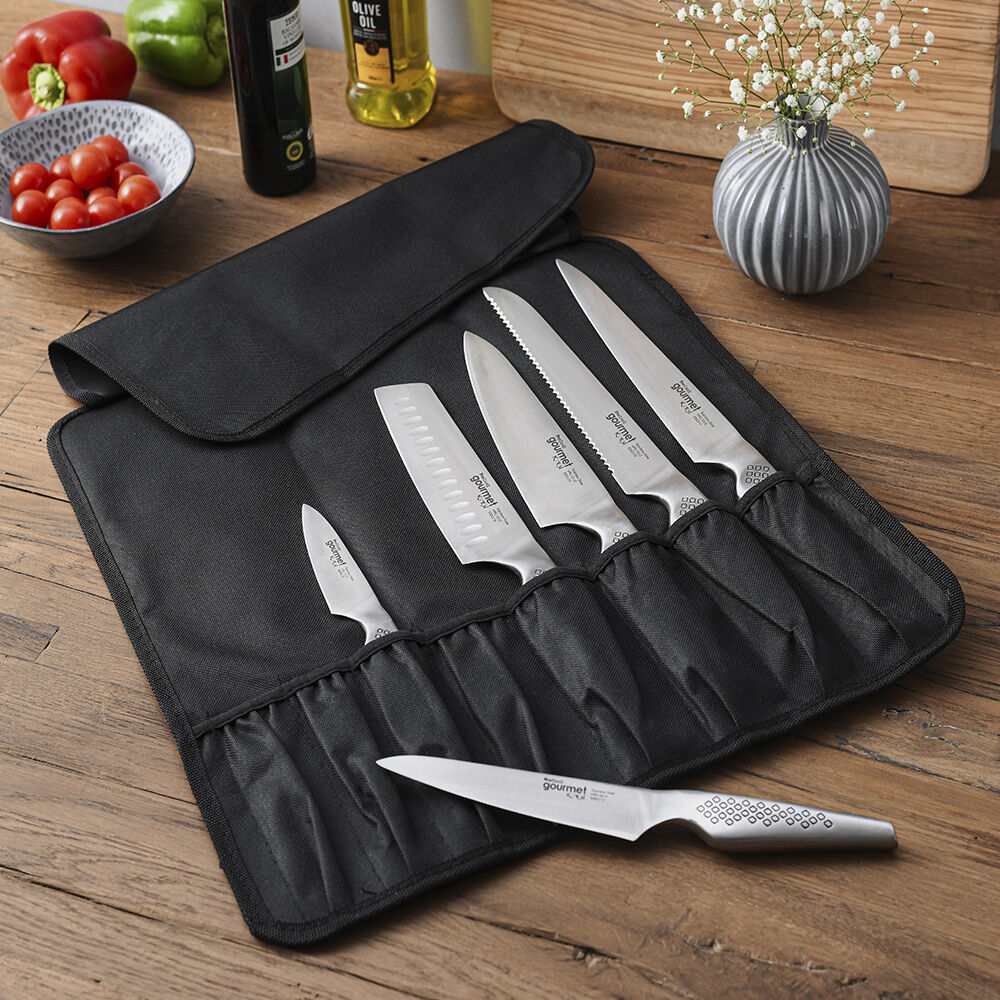
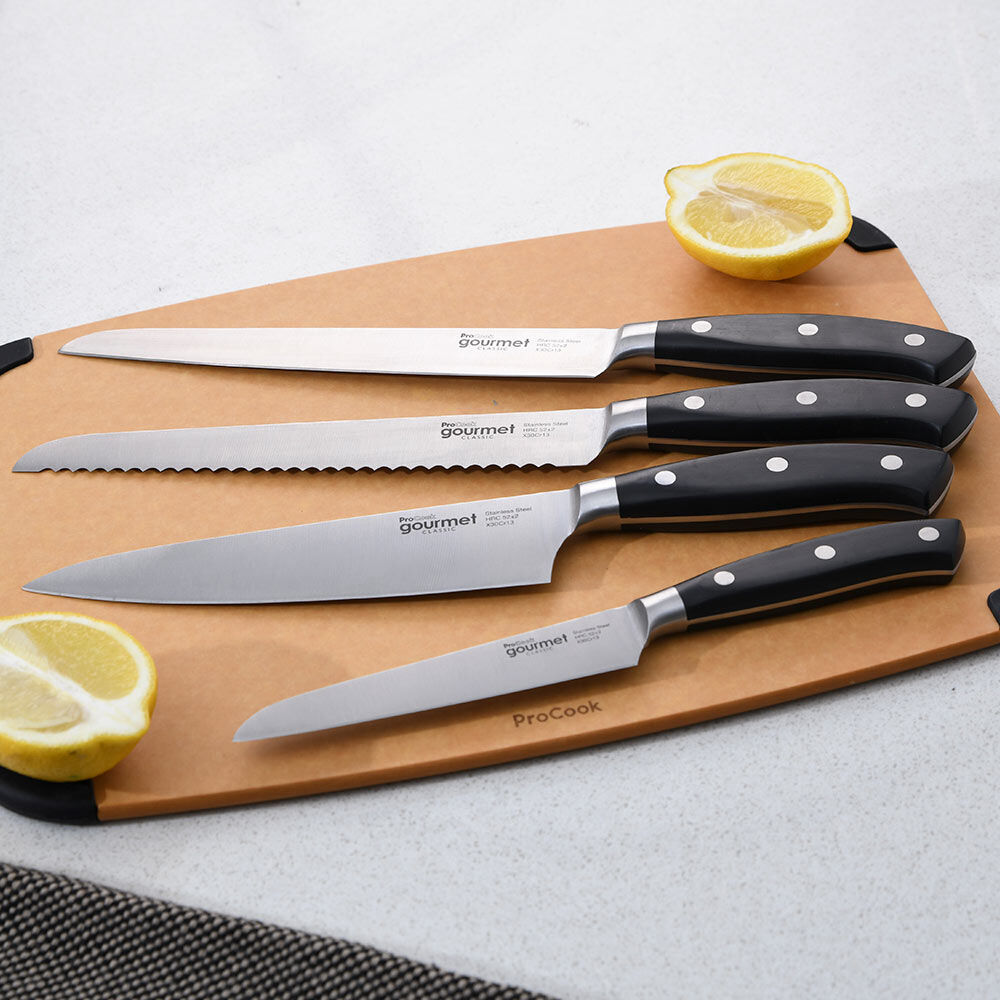
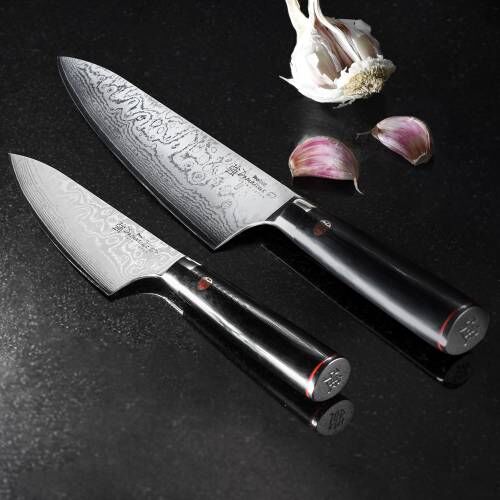
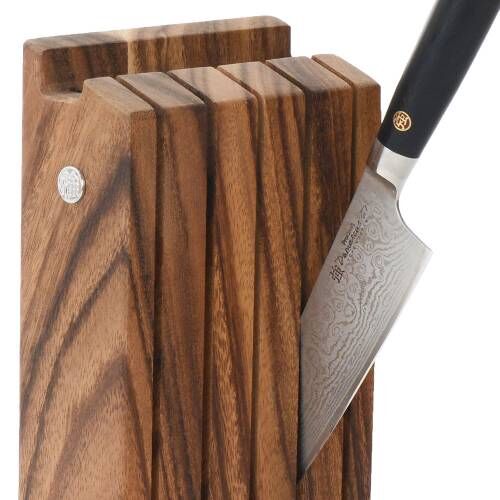
What's the Best Knife Material?
The material your knife is crafted from can greatly impact their strength, durability and sharpness. Knowing about the different knife materials can help you care for them.
Stainless Steel
Stainless steel is one of the most popular and common materials for knives due to the durability and protection from corrosion and rust it provides. Usually, stainless steel blades have a shiny finish and are strong enough to withstand a lot of use.
When shopping for a stainless steel knife, look for the carbon content in the product specification as this information provides indication of the knife's durability. Our stainless steel knives contain carbon to increase the knife's strength and longevity.
ProTip:
We recommend that stainless steel knives are not left submerged in water for long periods of time, as this can lead to pitting (corrosion) of the blade over time.
Carbon Steel
Created from a steel alloy made from carbon and iron, carbon steel blades offer exceptional strength and durability. However, carbon steel knives need to be looked after more vigilantly than stainless steel. For instance, if a carbon steel blade comes into contact with acidic foods, make sure to wipe it clean as soon as possible to avoid discolouration.
ProTip:
If you're wondering how to clean your carbon steel knife, look no further. Clean your carbon steel knife while you cook. This means wiping down your knife with a soft cloth after you've finished cutting each and every fruit and vegetable - especially if you are cutting a highly acidic food like lemons or tomatoes.
Damascus Steel
Damascus steel has a long history and has been used for knives and swords since medieval times - and for good reason. Damascus steel is extremely strong and long-lasting as well as sharp. However, that's not all. Numerous people absolutely love the beautiful appearance and pattern Damascus steel offers. The pattern is created because two or more different alloys are hammered together, creating a wavy pattern.
What are the Different Edges of a Knife?
Not all knife edges are the same, and different edges are required for certain knives so that they can cut through different foods. Having a basic understanding of the different knife edges can help you understand why a certain type of knife is created a certain way.
Straight Edge Knives (also known as Flat Ground Edge)
Considered the most common type of knife edge, the straight edge can also be referred to as the flat ground edge.
Straight edges are typically found on:
- Chef knives
- Utility knives
- Paring knives
- Carving knives
- Filleting knives
- Boning knives
Serrated Edge Knives
A serrated edge has grooves and ridges much like a saw so that you can slice through softer food without misshaping or crushing it.
Serrated edges are found on:
- Bread knives
- Tomato knives
- Steak knives
Hollow Ground Edge Knives
Seen on most Japanese knives, a hollow ground edge is what makes Japanese knives so sharp. A hollow ground edge tapers from the middle of the blade so that it creates such a fine and sharp edge. Although a hollow ground edge is incredibly sharp, it can also be more vulnerable to breakages. They may also need sharpening more frequently.
Hollow ground edges are often found on:
- Nakiri knives
Scalloped Edge Knives
Scalloped edges simply refer to blades that have dimples and are designed to stop food from sticking to the blade. The dimples help the sliced vegetables, meat or fruit slide off without harming the integrity of the food.
Scalloped edge knives can typically be found on:
- Santoku knives
- Salmon knives
Check these out:
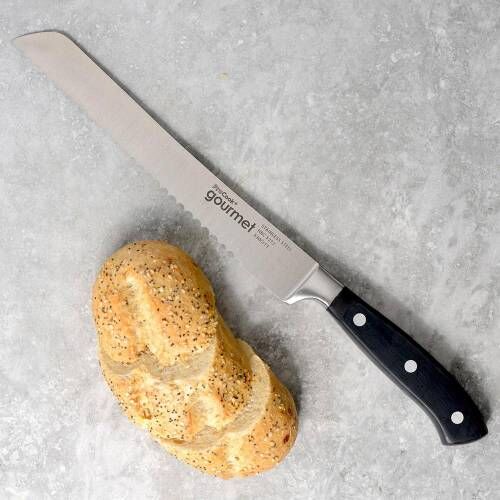

How to Sharpen and Store Your Kitchen Knives
Look after your kitchen knives well and they can last a lifetime. Regular sharpening and cleaning can improve the longevity of your knives while making them more effective. A blunt knife is not only dangerous but can make cutting much more difficult.
There are several knife sharpening and storage methods. We've created a couple handy guides, so you can take the best care of your knives.
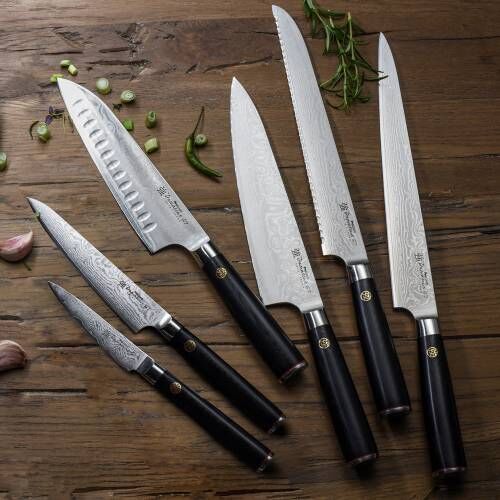
Our 6 piece Damascus 67 Knife Set is both beautiful and functional, featuring the traditional mottled pattern on the blade.


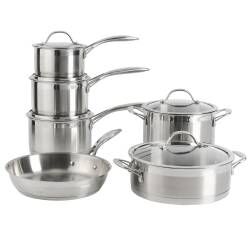
 Electricals
Electricals
 Coffee
Coffee
 Mixers and Blenders
Mixers and Blenders
 Kettles and Toasters
Kettles and Toasters
 Cooking
Cooking
 Small Appliances
Small Appliances
 Cookware & Bakeware
Cookware & Bakeware
 Pots and Pans
Pots and Pans
 Speciality Cookware
Speciality Cookware
 Baking
Baking
 Roasting
Roasting
 Knives
Knives
 Knife Sets
Knife Sets
 Single Knives
Single Knives
 Knife Accessories
Knife Accessories
 Tableware
Tableware
 Single Items
Single Items
 Serveware
Serveware
 Table Accessories
Table Accessories
 Outdoor Dining
Outdoor Dining
 Drinkware
Drinkware
 Hot Drinkware
Hot Drinkware
 Cafetieres and Teapots
Cafetieres and Teapots
 Drink Accessories
Drink Accessories
 Accessories
Accessories
 Kitchen Utensils
Kitchen Utensils
 Tools and Gadgets
Tools and Gadgets
 Storage
Storage
 Cleaning
Cleaning
 Summer desserts and baking
Summer desserts and baking
 Offers
Offers
 Gifting
Gifting

